Content
Dragon User followed a fairly standard model for computer magazines of the time: news, software and book reviews, technical Q+A, a number of regular columns and many program listings (in those days it was common for magazines to print the text of programs written in BASIC to be laboriously typed in by the reader). Special features, such as interviews with prominent figures in the software world were also quite common and of course there were many advertisements, mostly for Microdeal, the largest Dragon software producer.
Before November 1984, the software reviews were in the form of a continuous column written by John Scriven. Thereafter, the reviews appeared in a section called "Dragonsoft" where each program was reviewed separately and given a score of 1 to 5 Dragons. Various writers contributed reviews from then on, most notably Jason Orbaum, but also established Dragon programmers like Pam D'Arcy and Roy Coates.

The Dragon 32 and Dragon 64 are home computers that were built in the 1980s. The Dragons are very similar to the TRS-80 Color Computer, and were produced for the European market by Dragon Data, Ltd., initially in Swansea, Wales before moving to Port Talbot, Wales and by Eurohard S.A. in Casar de Cáceres, Spain, and for the US market by Tano of New Orleans, Louisiana. The model numbers reflect the primary difference between the two machines, which have 32 and 64 kilobytes of RAM, respectively.

Jerry Eugene Pournelle was an American polymath: scientist in the area of operations research and human factors research, science fiction writer, essayist, journalist, and one of the first bloggers. In the 1960s and early 1970s, he worked in the aerospace industry, but eventually focused on his writing career. In an obituary in Gizmodo, he is described as "a tireless ambassador for the future."
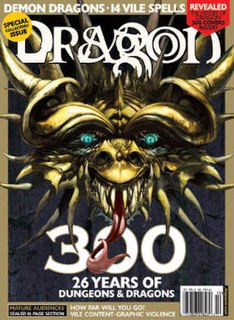
Dragon was one of the two official magazines for source material for the Dungeons & Dragons role-playing game and associated products; Dungeon was the other.

Bombuzal is a puzzle video game designed by Antony Crowther and David Bishop for Image Works. The game was released in 1988 for the Amiga, Atari ST and Commodore 64. It was also released in 1989 for MS-DOS and 1990 for the Super NES, with the North American version renamed as Ka-Blooey.

Run was an American computer magazine published monthly by IDG Communications with its first issue debuting in January 1984. Bi-monthly publishing began in June/July 1990, and went on until the magazine folded in November/December 1992. In its heyday, Run's monthly circulation was in the 200,000–300,000 range. Folio, the trade journal of the magazine industry, rated it as the second fastest-growing U.S. magazine of 1985.

Your Sinclair, or YS as it was commonly abbreviated, was a commercially published and printed British computer magazine for the Sinclair range of computers, mainly the ZX Spectrum. It was in circulation between 1984 and 1993.

GamePro was an American multiplatform video game magazine media company that published online and print content covering the video game industry, video game hardware and video game software. The magazine featured content on various video game consoles, PC computers and mobile devices. GamePro Media properties included GamePro magazine and their website. The company was also a part subsidiary of the privately held International Data Group (IDG), a media, events and research technology group.

PC Magazine is an American computer magazine published by Ziff Davis. A print edition was published from 1982 to January 2009. Publication of online editions started in late 1994 and continues to this day.

The Rainbow was a monthly magazine for the TRS-80 Color Computer by the Tandy Corporation. It was started by Lawrence C. Falk and was published from July 1981 to May 1993 by Falk's company, Falsoft, which was based in Prospect, Kentucky.

Loadstar was a disk magazine for the Commodore 64 computer, published starting in 1984 and ceasing publication in 2007 with its unreleased 250th issue. It derived its name from the command commonly used to execute commercial software from a Commodore 1541 disk: LOAD "*",8,1, with inspiration from the word "lodestar".

Popular Computing Weekly was a computer magazine in the UK published from 1982 to 1990. It was sometimes referred to as PCW.

Amstrad Computer User was the official magazine for the Amstrad CPC series of 8-bit home computers. This monthly publication, usually referred to as ACU by its readers, concentrated more on the hardware and technical side of the Amstrad range, although it had a small dedicated games section as well.
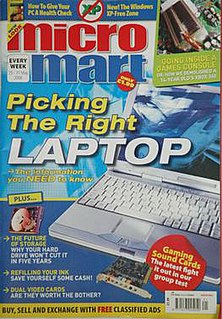
Micro Mart was a weekly computer magazine published in the United Kingdom by Dennis Publishing Ltd.. As of 2015, it had a circulation of 5,422. In a letter to subscribers in December 2016 it was announced that the magazine would cease publication with issue No 1445 : "After 30 amazing years of telling it like it is, Micro Mart magazine is logging off."
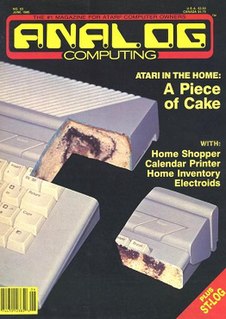
ANALOG Computing was an American computer magazine devoted to Atari 8-bit family of home computers. It was published from 1981 until 1989. In addition to reviews and tutorials, ANALOG printed multiple programs in each issue for users to type in. The magazine had a reputation for listings of machine language games–much smoother than those written in Atari BASIC—and which were uncommon in competing magazines. Such games were accompanied by the assembly language source code. ANALOG also sold commercial games, two books of type-in software, and access to a custom bulletin-board system.
Mel Croucher is a British entrepreneur and video games pioneer. Originally an architect, he moved into computers and in 1977 launched one of the very earliest games companies, Automata UK, as an extension of his travel guide publishing business. He is now credited for setting up "the first games company in the U.K.", celebrated as "the father of the British videogames industry" and presented as "a pioneer in affective computing". His first broadcasts of computer game software were made over AM and FM radio. After the release of the Sinclair ZX81, his label published several games for the early home computer market, including three Computer Trade Association award-winners: Pimania (1982), Groucho, and the groundbreaking "multi-media" title Deus Ex Machina (1984).
SoftSide is a defunct computer magazine, begun in October 1978 by Roger Robitaille and published by SoftSide Publications of Milford, New Hampshire.
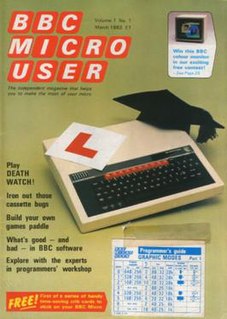
The Micro User was a British specialist magazine catering to users of the BBC Microcomputer series, Acorn Electron, Acorn Archimedes and, to a limited extent, the Cambridge Z88. It had a comprehensive mix of reviews of games, application software, and the latest Acorn computers; type-in programs, a correspondence page offering help with computer problems, and approachable technical articles on programming and the BBC Micro's internals.
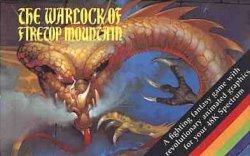
The Warlock of Firetop Mountain is an arcade adventure video game released by Crystal Computing in 1984 for the Sinclair ZX Spectrum home computer. It is loosely based on the adventure gamebook of the same name written by Steve Jackson and Ian Livingstone, and published by Puffin Books in 1982.

Byte was an American microcomputer magazine, influential in the late 1970s and throughout the 1980s because of its wide-ranging editorial coverage. Whereas many magazines were dedicated to specific systems or the home or business users' perspective, Byte covered developments in the entire field of "small computers and software", and sometimes other computing fields such as supercomputers and high-reliability computing. Coverage was in-depth with much technical detail, rather than user-oriented. Byte started in 1975, shortly after the first personal computers appeared as kits advertised in the back of electronics magazines. Byte was published monthly, with an initial yearly subscription price of $10. Print publication ceased in 1998 and online publication in 2013.

Personal Computer News (PCN) was a magazine publication which reviewed software and hardware for computers. It was published initially fortnightly, and during the boom period of home computing within the United Kingdom. It was published by VNU Publications and had a female editor, Cyndy Miles, unusual for computer magazines of the time.


















